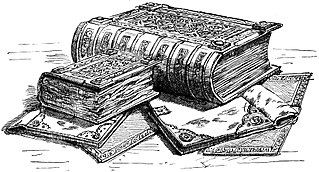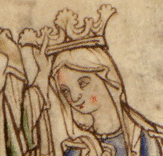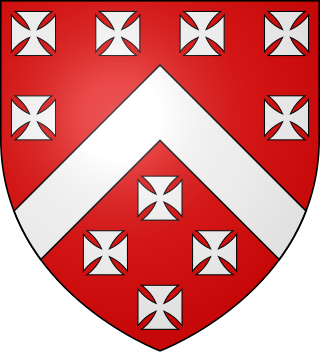Related Research Articles

Domesday Book is a manuscript record of the Great Survey of much of England and parts of Wales completed in 1086 at the behest of King William the Conqueror. The manuscript was originally known by the Latin name Liber de Wintonia, meaning "Book of Winchester", where it was originally kept in the royal treasury. The Anglo-Saxon Chronicle states that in 1085 the king sent his agents to survey every shire in England, to list his holdings and dues owed to him.

Edith of Wessex was Queen of England through her marriage to Edward the Confessor from 1045 until Edward's death in 1066. Unlike most English queens in the 10th and 11th centuries, she was crowned. The principal source on her life is a work she herself commissioned, the Vita Ædwardi Regis or the Life of King Edward who rests at Westminster, which is inevitably biased.
Æthelwine was the last Anglo-Saxon bishop of Durham, the last who was not also a secular ruler, and the only English bishop at the time of the Norman Conquest who did not remain loyal to King William the Conqueror.

The Berkeley family is an ancient English noble family. It is one of only five families in Britain that can trace its patrilineal descent back to an Anglo-Saxon ancestor. The Berkeley family retains possession of much of the lands it held from the 11th and 12th centuries, centred on Berkeley Castle in Gloucestershire, which still belongs to the family.

Ralph the Staller or Ralf the Englishman was a noble and landowner in both Anglo-Saxon and post-Conquest England. He first appears in charters from Brittany, where he was described as Ralph / Ralf the Englishman, and it was in Brittany that his son Ralph de Gaël held a large hereditary lordship.

Clavering Castle remains are situated in the small parish village of Clavering in the county of Essex, England, 50m north of the church of St Mary and St Clement on the southern bank of the River Stort, some 10 kilometres (6.2 mi) north of Bishop's Stortford.
Osgod Clapa, also Osgot, was a nobleman in Anglo-Saxon England during the reigns of Kings Cnut the Great, Harold Harefoot, Harthacnut, and Edward the Confessor. His name comes from the Old Danish Asgot, the byname Clapa perhaps meaning coarse, or rough, in Old Norse. He was a major landowner in East Anglia during a period in which no Ealdorman was appointed to the region. He held the post of staller, that is constable or master of the royal stables. In 1046 he was banished, and in 1054 he died.
Richard Scrob was a Frenchman who came to England prior to the Norman Conquest of England.
Events from the 1060s in England.

Robert fitz Wimarc was a kinsman of both Edward the Confessor and William of Normandy, and was present at Edward's death bed.
Urse d'Abetot was a Norman who followed King William I to England, and became Sheriff of Worcestershire and a royal official under him and Kings William II and Henry I. He was a native of Normandy and moved to England shortly after the Norman Conquest of England in 1066, and was appointed sheriff in about 1069. Little is known of his family in Normandy, who were not prominent, but he probably got his name from the village Abetot. Although Urse's lord in Normandy was present at the Battle of Hastings, there is no evidence that Urse took part in the invasion of England in 1066.
Tovi the Proud, fl. 1018–1043, was a rich and powerful 11th-century Danish thegn who held a number of estates in various parts of southern England. A translation of the legend of Waltham Abbey cites the Lord of Waltham as 'Tovi le Prude', "totius Angliae post regnem primus". He was staller to King Cnut the Great.
Eadnoth the Constable also known as Eadnoth the Staller, was an Anglo-Saxon landowner and steward to kings Edward the Confessor and Harold Godwinson. He is mentioned in the Domesday Book as holding thirty manors in Devon, Dorset, Somerset, and Wiltshire, before the Norman conquest. He may have been the same man as Eadnoth of Ugford, also known as Alnoth. Eadnoth was killed at Bleadon in 1068, leading a force against the two sons of Harold II, who had invaded Somerset. His son Harding became Sheriff of Bristol, and one of his grandsons was Robert Fitzharding, the ancestor of the Berkeley family of Berkeley Castle.
Harding of Bristol or Harding Fitz Eadnoth was sheriff reeve of Bristol, with responsibility for managing a manorial estate and perhaps similar duties to those of a magistrate. He was the son of Eadnoth the Constable, an Anglo-Saxon thane who served as steward to Edward the Confessor and Harold II. He was the father of Robert Fitzharding who became lord of Berkeley, Gloucestershire.

The extent of the medieval district of Craven, in the north of England is a matter of debate. The name Craven is either pre-Celtic Britain, Britonnic or Romano-British in origin. However, its usage continued following the ascendancy of the Anglo-Saxons and the Normans – as was demonstrated by its many appearances in the Domesday Book of 1086. Places described as being In Craven in the Domesday Book fell later within the modern county of North Yorkshire, as well as neighbouring areas of West Yorkshire, Lancashire and Cumbria. Usage of Craven in the Domesday Book is, therefore, circumstantial evidence of an extinct, British or Anglo-Saxon kingdom or subnational entity.

Bondi the Staller, also known as 'Boding', was a wealthy Anglo-Danish landowner, thegn, and member of Edward the Confessor's personal household.
Godwin or Godwine was a son, probably the eldest son, of Harold Godwinson, King of England. He was driven into exile in Dublin, along with two of his brothers, by the Norman conquest of England, and from there he twice led expeditions to south-western England, but with little success.
Edmund or Eadmundᚪᛖᛞᛘᚩᚾᛞ or Ædmund was a son of Harold Godwinson, King of England. He was driven into exile in Dublin by the Norman conquest of England, along with two of his brothers, and from there he twice took part in expeditions to south-western England, but with little success. He disappears from history in the early 1070s.
Magnus was a son of Harold Godwinson, King of England. He was, in all likelihood, driven into exile in Dublin by the Norman conquest of England, along with two of his brothers, and from there took part in one, or perhaps two, expeditions to south-western England, but with little military success. They probably cost him his life.

Ansgar the Staller or Esegar was one of the wealthiest and most powerful nobles in late Anglo-Saxon England. He escaped badly wounded from the Battle of Hastings in October 1066, then led the defence of London.
References
- Barnwell, PS (2006). Emperor, Prefects & Kings: The Roman West, 395-565. The University of North Carolina Press. ISBN 978-0807820711.
- "Constable, or Staller". Hull Domesday Project. Retrieved 18 April 2020.
- Larson, Laurence Marcellus (1904). The King's Household in England Before the Norman Conquest. Madison, Wisconsin, US: University of Wisconsin. ISBN 978-0-7222-2854-8.
- Lyon, Bryce (1980). A Constitutional and Legal History of Medieval England (2nd ed.). W. W. Norton & Company. ISBN 0-393-95132-4. 1st edition available to read online here.
- Williams, Ann (2008). The World Before Domesday: The English Aristocracy, 900–1066. London: Continuum. ISBN 9781847252395.